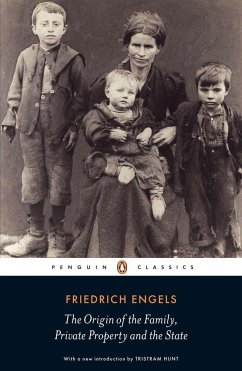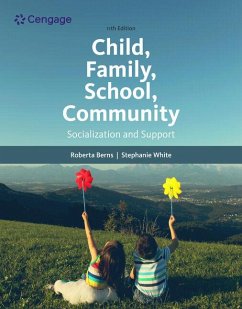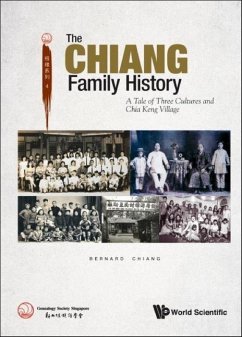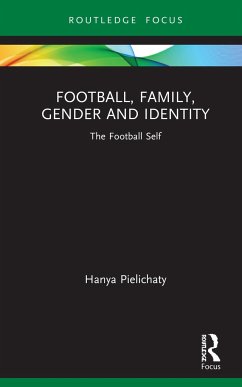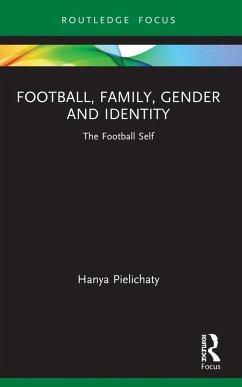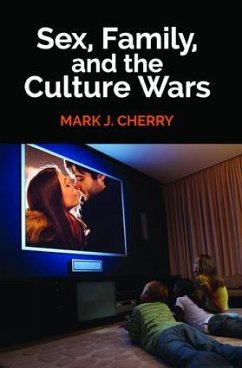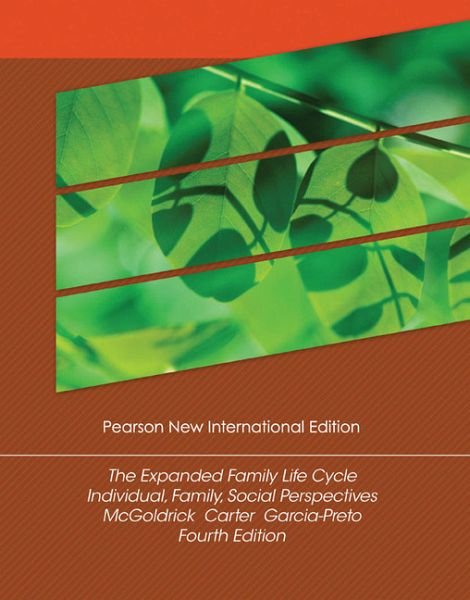
Expanded Family Life Cycle, The: Individual, Family, and Social Perspectives
Pearson New International Edition

PAYBACK Punkte
54 °P sammeln!
This classic Family Therapy text continues to provide “a new and more comprehensive way to think about human development and the life cycle,” reflecting changes in society away from orientation toward the nuclear family, toward a more diverse and inclusive definition of “family.”
This expanded view of the family includes the impact of issues at multiple levels of the human system: the individual, family households, the extended family, the community, the cultural group, and the larger society. The text features a ground-breaking integration of individual male and female development in systemic context; our increasing racial, ethnic, and cultural diversity; the emergence of men's movements and issues; the growing visibility of lesbian and gay families; and the neglected area of social class.
Features + Benefits
Create a Custom Text: For enrollments of at least 25, create your own textbook by combining chapters from best-selling Pearson textbooks and/or reading selections in the sequence you want. To begin building your custom text, visit www.pearsoncustomlibrary.com. You may also work with a dedicated Pearson Custom editor to create your ideal text–publishing your own original content or mixing and matching Pearson content. Contact your Pearson Publisher’s Representative to get started.
Boasts a lively and dynamic writing style, coupled with contributions by some of the best-known therapists and experts in family therapy, integrating theory and research with clinical guidelines and cases.
Features a wide perspective of family therapy that includes diversity of family forms and lifestyles, as well as cultural diversity.
A broad textual focus highlights the reciprocity between two neglected areas:
How the individual self develops in the context of relationships that are shaped by community and social norms, which greatly influence the individual's degree of autonomy and emotional connectedness, his or her values, beliefs, dreams, spirituality, use of time and energy, and connection to work, politics, and community.
Specific ways that the norms of community and the larger society—especially regarding race, class, gender, culture, and sexual orientation—affect individuals and their family relationships. The text offers numerous ideas for dealing with these dimensions in clinical work.
Maintains a feminist and cultural perspective throughout.
Contains chapters on men's issues, individual development, a clinical method based on Bowen's coaching model, class, violence, migration, lesbians and gays, siblings, and never-married adults.
PART I: PERSPECTIVES ON THE EVOLVING FAMILY LIFE CYCLE
Chapter 1: Overview: The Life Cycle in its Changing Context: Individual, Family and Social Perspectives
Monica McGoldrick, Betty Carter, Nydia Garcia Preto
Introduction: The Family Life Cycle: A System Moving Through Time
The Changing Family Life Cycle
Human Development in Context
The Vertical and Horizontal Flow of Stress in the Life Cycle
Anxiety and Symptom Development
Cohorts: When and Where in Time and Place We Are Located
Understanding Changing Families in Context
Friendship Through the Life Cycle
The Changing Family Life Cycle of Men and Women
Homeplace: The Importance of Belonging Throughout the Life Cycle
Power and Privilege Given to Some Groups over Others Because of the Hierarchical Rules and Norms Held by Religious, Social, Business, or Governmental Institutions
Life Cycle Stages: A Provisional Framework
Conclusion
Chapter 2 : Self in Contect: Human Development and the Individual Life Cycle in Systemic Perspective
Monica McGoldrick, Betty Carter, & Nydia Garcia Preto
Redefining the Dimensions of Human Development
Developing a Self in Context
The Myths of Complete Autonomy and Self-Determination
Developing a Mature Interdependent Self
Gendered Development
Developing a Self in a Nonaffirming Environment
Our Multiple Intelligences
The Connected Self Countering Unequal Gender, Class, Cultural, and Racial Socialization
The “Slings and Arrows” as Individual, Family, and Community Intersect
The Individual Life Cycle in Context: Developing an Autonomous and Emotionally Connected Self
Chapter 3: Women and the Family Life Cycle
Monica McGoldrick
Women’s Changing Life Cycle Roles
Women and Education
Women and Work
Women in Families
Women in the Middle: Women and Caretaking
Women’s Exclusion From Power Under the Law and Societal Expectations
Women and Marriage
Becoming Mothers
Adolescence
Launching Children and Moving On
Older Families
Women and Their Friendship Networks
Women and Loss
Conclusion: That the Bumble Bee Should Fly: Affirming Women Through the Life Cycle
Chapter 4: Men and the Life Cycle: Diversity and Complexity
Matthew R. Mock
Introduction
Men: A View of Their Relationships Across Generations
Men in Multiple, Mutual Relationships Across the Life Span
The Intersection of Gender and Other Social Complexities
Gender as a Significant Matter
An Understanding of Intersectionality and Male Power
Childhood
Adolescence
Young Adulthood
Men as Partners and Husbands
Fatherhood
Men at Midlife
Men as Friends With Other Men, Women and Friendship Networks
Men, Work, and Family Health
Elders and Older Age
Conclusion and Areas of Future Focus
Chapter 5: Social Class and the Life Cycle
Jodie Kliman
Introduction
Understanding Social Class
Case Examples
Social Class and Families With Young Children
Social Class and Families With Older Children and Adolescents
Social Class and Families With Late Adolescents and Young Adults
Social Class and Families With Adults in Mid- and Later Life
Conclusions: Implications for Family Therapy
Chapter 6 Sexuality and the Life Cycle
Ellen Berman & David Wohlsifer
The Biology of Sexuality
Sexuality and Gender Across the Life Cycle
Sexuality Through the Life Cycle
Conclusion
Chapter7: Lesbian, Gay, Bisexual, and Transgender Individuals and the Family Life Cycle
Deidre Ashton
Introduction
Current Status of LGBT Families in the United States
Diversity Among LGBT Families
Models of LGBT Identity Development
Lesbian and Gay Identity Development
Bisexual Identity Development
Transgender Identity Development
Coming Out
The Family Life Cycle
Leaving Home and Staying Connected: Launching and Single Adulthood
Coupling
Parenting: Families With Young Children
Parenting: Families With Adolescent Children Families in Later Life
Conclusion
Chapter 8: Spirituality and the Family Life Cycle
Sueli Petry
Spirituality and Religion in America
Family Life Cycle Theory and Application to Context of Spirituality
Children and Spirituality
Adolescence: Identity Development and Spirituality
Early Adulthood: Time to Explore and Make Choices About Spiritual Beliefs
Middle-Age: Beliefs Reaffirmed
Older Adults: Aging and Facing Mortality
Conclusion
Chapter 9 Siblings and the Life Cycle
Monica McGoldrick & Marlene Watson
The Importance of Sibling Relationships Through the Life Cycle
Age Spacing
Gender Differences
Birth-Order Effects in Sibling Relationships
Life Cycle Issues in Families With Disabled Siblings
Sibling Positions and Parenting
Siblings and Adolescent Relationships
Sibling Relationships in Young Adulthood
Sibling Positions and Marital Relationships
In-Laws, Step- and Half Siblings Sibling Relationships in Midlife
Sibling Relationships After the Death of Parents
Other Factors That Intersect With Sibling Patterns: Culture, Class, and Race
Rules of Thumb for Sibling Relationships Through the Life Cycle
Conclusions
Chapter 10: Single Adults and the Life Cycle
Kathy Berliner, Demaris Jacob, & Natalie Schwartzberg
The Single Adult and the Family Life Cycle
Setting the Clinical Stage
The Single Person’s Life Cycle
The Stages
PART II: LIFE CYCLE TRANSITIONS AND PHASES
Chapter 11: Becoming and Adult: Finding Ways to Love and Work
Richard H. Fulmer
Young Adulthood(s) in the New Century
Early Young Adulthood: Developmental Tasks
Work Tasks: Preparation Without Pay or Earning out of Necessity?
Relationship Tasks: Trying to Find Love in Lust
Early Young Adulthood: Ages 18 to 21
Later Young Adulthood, Ages 22 to 30: Trying to Consolidate Work and Family
Young Adulthood for Men
Anticipation of Death
Barriers to Affiliation for Men
Affiliation: Can Fathers Help?
Young Adulthood for Women
Anticipation of Birth
Conclusion: Young Adulthood as a Transition for Three Generations
Chapter 12: Becoming a Couple
Monica McGoldrick
Marriage in Our Times
Fusion and Intimacy
Gay and Lesbian Couples
The Wedding
Sexuality
Patterns With Extended Family
In-Laws
Sibling Issues in Couple Formation
Cultural Differences
Chapter 13: Becoming Parents: The Family with Young Children
Betty Carter, Monica McGoldrick, & Barbara Petkov
Introduction
Expectations Versus Reality
The New Demographics of Families in the Parenting Phase
The Emotional System
Child Care and the Work—Family Dilemma
Gender Issues in Parenting: The Power Imbalance
Child-Rearing
Alternate Pathways to Parenthood
Lesbian and Gay Parenting
Foster Care
Clinical Guidelin
This expanded view of the family includes the impact of issues at multiple levels of the human system: the individual, family households, the extended family, the community, the cultural group, and the larger society. The text features a ground-breaking integration of individual male and female development in systemic context; our increasing racial, ethnic, and cultural diversity; the emergence of men's movements and issues; the growing visibility of lesbian and gay families; and the neglected area of social class.
Features + Benefits
Create a Custom Text: For enrollments of at least 25, create your own textbook by combining chapters from best-selling Pearson textbooks and/or reading selections in the sequence you want. To begin building your custom text, visit www.pearsoncustomlibrary.com. You may also work with a dedicated Pearson Custom editor to create your ideal text–publishing your own original content or mixing and matching Pearson content. Contact your Pearson Publisher’s Representative to get started.
Boasts a lively and dynamic writing style, coupled with contributions by some of the best-known therapists and experts in family therapy, integrating theory and research with clinical guidelines and cases.
Features a wide perspective of family therapy that includes diversity of family forms and lifestyles, as well as cultural diversity.
A broad textual focus highlights the reciprocity between two neglected areas:
How the individual self develops in the context of relationships that are shaped by community and social norms, which greatly influence the individual's degree of autonomy and emotional connectedness, his or her values, beliefs, dreams, spirituality, use of time and energy, and connection to work, politics, and community.
Specific ways that the norms of community and the larger society—especially regarding race, class, gender, culture, and sexual orientation—affect individuals and their family relationships. The text offers numerous ideas for dealing with these dimensions in clinical work.
Maintains a feminist and cultural perspective throughout.
Contains chapters on men's issues, individual development, a clinical method based on Bowen's coaching model, class, violence, migration, lesbians and gays, siblings, and never-married adults.
PART I: PERSPECTIVES ON THE EVOLVING FAMILY LIFE CYCLE
Chapter 1: Overview: The Life Cycle in its Changing Context: Individual, Family and Social Perspectives
Monica McGoldrick, Betty Carter, Nydia Garcia Preto
Introduction: The Family Life Cycle: A System Moving Through Time
The Changing Family Life Cycle
Human Development in Context
The Vertical and Horizontal Flow of Stress in the Life Cycle
Anxiety and Symptom Development
Cohorts: When and Where in Time and Place We Are Located
Understanding Changing Families in Context
Friendship Through the Life Cycle
The Changing Family Life Cycle of Men and Women
Homeplace: The Importance of Belonging Throughout the Life Cycle
Power and Privilege Given to Some Groups over Others Because of the Hierarchical Rules and Norms Held by Religious, Social, Business, or Governmental Institutions
Life Cycle Stages: A Provisional Framework
Conclusion
Chapter 2 : Self in Contect: Human Development and the Individual Life Cycle in Systemic Perspective
Monica McGoldrick, Betty Carter, & Nydia Garcia Preto
Redefining the Dimensions of Human Development
Developing a Self in Context
The Myths of Complete Autonomy and Self-Determination
Developing a Mature Interdependent Self
Gendered Development
Developing a Self in a Nonaffirming Environment
Our Multiple Intelligences
The Connected Self Countering Unequal Gender, Class, Cultural, and Racial Socialization
The “Slings and Arrows” as Individual, Family, and Community Intersect
The Individual Life Cycle in Context: Developing an Autonomous and Emotionally Connected Self
Chapter 3: Women and the Family Life Cycle
Monica McGoldrick
Women’s Changing Life Cycle Roles
Women and Education
Women and Work
Women in Families
Women in the Middle: Women and Caretaking
Women’s Exclusion From Power Under the Law and Societal Expectations
Women and Marriage
Becoming Mothers
Adolescence
Launching Children and Moving On
Older Families
Women and Their Friendship Networks
Women and Loss
Conclusion: That the Bumble Bee Should Fly: Affirming Women Through the Life Cycle
Chapter 4: Men and the Life Cycle: Diversity and Complexity
Matthew R. Mock
Introduction
Men: A View of Their Relationships Across Generations
Men in Multiple, Mutual Relationships Across the Life Span
The Intersection of Gender and Other Social Complexities
Gender as a Significant Matter
An Understanding of Intersectionality and Male Power
Childhood
Adolescence
Young Adulthood
Men as Partners and Husbands
Fatherhood
Men at Midlife
Men as Friends With Other Men, Women and Friendship Networks
Men, Work, and Family Health
Elders and Older Age
Conclusion and Areas of Future Focus
Chapter 5: Social Class and the Life Cycle
Jodie Kliman
Introduction
Understanding Social Class
Case Examples
Social Class and Families With Young Children
Social Class and Families With Older Children and Adolescents
Social Class and Families With Late Adolescents and Young Adults
Social Class and Families With Adults in Mid- and Later Life
Conclusions: Implications for Family Therapy
Chapter 6 Sexuality and the Life Cycle
Ellen Berman & David Wohlsifer
The Biology of Sexuality
Sexuality and Gender Across the Life Cycle
Sexuality Through the Life Cycle
Conclusion
Chapter7: Lesbian, Gay, Bisexual, and Transgender Individuals and the Family Life Cycle
Deidre Ashton
Introduction
Current Status of LGBT Families in the United States
Diversity Among LGBT Families
Models of LGBT Identity Development
Lesbian and Gay Identity Development
Bisexual Identity Development
Transgender Identity Development
Coming Out
The Family Life Cycle
Leaving Home and Staying Connected: Launching and Single Adulthood
Coupling
Parenting: Families With Young Children
Parenting: Families With Adolescent Children Families in Later Life
Conclusion
Chapter 8: Spirituality and the Family Life Cycle
Sueli Petry
Spirituality and Religion in America
Family Life Cycle Theory and Application to Context of Spirituality
Children and Spirituality
Adolescence: Identity Development and Spirituality
Early Adulthood: Time to Explore and Make Choices About Spiritual Beliefs
Middle-Age: Beliefs Reaffirmed
Older Adults: Aging and Facing Mortality
Conclusion
Chapter 9 Siblings and the Life Cycle
Monica McGoldrick & Marlene Watson
The Importance of Sibling Relationships Through the Life Cycle
Age Spacing
Gender Differences
Birth-Order Effects in Sibling Relationships
Life Cycle Issues in Families With Disabled Siblings
Sibling Positions and Parenting
Siblings and Adolescent Relationships
Sibling Relationships in Young Adulthood
Sibling Positions and Marital Relationships
In-Laws, Step- and Half Siblings Sibling Relationships in Midlife
Sibling Relationships After the Death of Parents
Other Factors That Intersect With Sibling Patterns: Culture, Class, and Race
Rules of Thumb for Sibling Relationships Through the Life Cycle
Conclusions
Chapter 10: Single Adults and the Life Cycle
Kathy Berliner, Demaris Jacob, & Natalie Schwartzberg
The Single Adult and the Family Life Cycle
Setting the Clinical Stage
The Single Person’s Life Cycle
The Stages
PART II: LIFE CYCLE TRANSITIONS AND PHASES
Chapter 11: Becoming and Adult: Finding Ways to Love and Work
Richard H. Fulmer
Young Adulthood(s) in the New Century
Early Young Adulthood: Developmental Tasks
Work Tasks: Preparation Without Pay or Earning out of Necessity?
Relationship Tasks: Trying to Find Love in Lust
Early Young Adulthood: Ages 18 to 21
Later Young Adulthood, Ages 22 to 30: Trying to Consolidate Work and Family
Young Adulthood for Men
Anticipation of Death
Barriers to Affiliation for Men
Affiliation: Can Fathers Help?
Young Adulthood for Women
Anticipation of Birth
Conclusion: Young Adulthood as a Transition for Three Generations
Chapter 12: Becoming a Couple
Monica McGoldrick
Marriage in Our Times
Fusion and Intimacy
Gay and Lesbian Couples
The Wedding
Sexuality
Patterns With Extended Family
In-Laws
Sibling Issues in Couple Formation
Cultural Differences
Chapter 13: Becoming Parents: The Family with Young Children
Betty Carter, Monica McGoldrick, & Barbara Petkov
Introduction
Expectations Versus Reality
The New Demographics of Families in the Parenting Phase
The Emotional System
Child Care and the Work—Family Dilemma
Gender Issues in Parenting: The Power Imbalance
Child-Rearing
Alternate Pathways to Parenthood
Lesbian and Gay Parenting
Foster Care
Clinical Guidelin
Dieser Artikel kann nur an eine deutsche Lieferadresse ausgeliefert werden.




